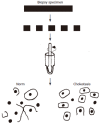Concept on the pathogenesis and treatment of primary biliary cirrhosis
- PMID: 17143938
- PMCID: PMC4087480
- DOI: 10.3748/wjg.v12.i45.7250
Concept on the pathogenesis and treatment of primary biliary cirrhosis
Abstract
Primary biliary cirrhosis (PBC) is an organ-specific autoimmune disease that predominantly affects women and is characterized by chronic, progressive destruction of small intrahepatic bile ducts with portal inflammation and ultimately fibrosis, leading to liver failure in the absence of treatment. Little is known about the etiology of PBC. PBC is characterized by anti-mitochondrial antibodies and destruction of intra-hepatic bile ducts. The serologic hallmark of PBC is the presence of auto-antibodies to mitochondria, especially to the E2 component of the pyruvate dehydrogenase complex (PDC). Current theories on the pathogenesis of PBC favor the hypothesis that the disease develops as a result of an inappropriate immune response following stimulation by an environmental or infectious agent. Some reports suggest that xenobiotics and viral infections may induce PBC. The pathogenetic mechanism is believed to be caused by a defect in immunologic tolerance, resulting in the activation and expansion of self-antigen specific T and B lymphocyte clones and the production of circulating autoantibodies in addition to a myriad of cytokines and other inflammatory mediators. This leads to ductulopenia and persistent cholestasis, by developing end-stage hepatic-cell failure. In this review are given our own and literary data about mechanisms of development of intrahepatic cholestasis and possible ways of its correction.
Figures






References
-
- Loginov АС. Classification and nomenclature of chronic liver diseases. Rossiyskiy Gastroenterologicheskiy Zhurnal. 1995;2:3–8.
-
- Charatcharoenwitthaya P, Lindor KD. Current concepts in the pathogenesis of primary biliary cirrhosis. Ann Hepatol. 2005;4:161–175. - PubMed
-
- Leung PS, Coppel RL, Gershwin ME. Etiology of primary biliary cirrhosis: the search for the culprit. Semin Liver Dis. 2005;25:327–336. - PubMed
-
- Gershwin ME, Selmi C. Apocalypsal versus apocryphal: the role of retroviruses in primary biliary cirrhosis. Am J Gastroenterol. 2004;99:2356–2358. - PubMed
Publication types
MeSH terms
Substances
LinkOut - more resources
Full Text Sources

